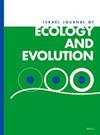Behavioral activity and range patterns of the endemic Gelada monkey (Theropithecus gelada) in and around Jer Silase Monastery in North Shoa Zone, Ethiopia
IF 0.8
4区 环境科学与生态学
Q3 ECOLOGY
引用次数: 0
Abstract
Abstract The present study investigated the activity, range, and habitat utilization patterns of the Endemic Gelada Monkey ( Theropithecus gelada ) in and around Jer Silase Monastery in North Shoa Zone, Ethiopia. The study was conducted from January 2021 to October 2021 by considering the dry and wet seasons and stratifying the study area into natural forest, cliff/rocky, and farmland habitats. An instantaneous scan sampling method was employed to collect behavioral data. The activity patterns of three selected focal groups of Gelada monkeys were studied. GPS points of their predominant behavioral activities were recorded daily every 15 minutes from 7:00 to 18:00 for 12 days every month. A total of 5,592 individual activity records were obtained from 2312 scan samplings taken over 120 study days. Feeding comprised 54.52% of the activity time, followed by moving at 20.67% and socialization at 11.95%. A multivariate analysis of variance (MANOVA) revealed that the time allocated to different activity types varied significantly over the year with the month (Roy’s Largest Root = 2.7, F 4,22 = 13.2, p < 0.001, partial η2 = 0.653). The longest mean monthly travel distance was 2817.61 ± 582.57 m, recorded at the Cliff/rocky habitat during the wet season. Gelada monkeys’ daily range length and home range size extended more in the dry season. These findings may be explained by reduced habitat quality associated with livestock grazing, agricultural expansion, and charcoal production. Therefore, appropriate conservation measures should be implemented to minimize such adverse effects and conserve the endemic Gelada Monkey.埃塞俄比亚北部Shoa区Jer Silase修道院及其周围地区特有狒狒(Theropithecus Gelada)的行为活动和范围模式
摘要本研究调查了埃塞俄比亚北部Shoa地区Jer Silase修道院及其周边地区特有狒狒(Theropithecus Gelada)的活动、活动范围和栖息地利用模式。该研究于2021年1月至2021年10月进行,考虑了干湿季节,并将研究区域分为天然林、悬崖/岩石和农田栖息地。采用瞬时扫描采样法采集行为数据。选择三个焦点群对狒狒的活动模式进行了研究。每月12天,每天7点至18点,每15分钟记录一次其主要行为活动的GPS点。在120个研究天的时间里,从2312个扫描样本中获得了5,592个个人活动记录。进食占活动时间的54.52%,其次是移动占20.67%,社交占11.95%。多变量方差分析(MANOVA)显示,分配给不同活动类型的时间在一年和月份之间变化显著(Roy 's最大根= 2.7,f4,22 = 13.2, p <0.001,偏η2 = 0.653)。月平均移动距离最长,为2817.61±582.57 m,主要发生在崖岩生境。狒狒的日常活动范围和活动范围在旱季扩大得更多。这些发现可以用与放牧、农业扩张和木炭生产相关的栖息地质量下降来解释。因此,应采取适当的保护措施,尽量减少这些不利影响,保护当地特有的狒狒。
本文章由计算机程序翻译,如有差异,请以英文原文为准。
求助全文
约1分钟内获得全文
求助全文
来源期刊

Israel Journal of Ecology & Evolution
环境科学-进化生物学
CiteScore
2.10
自引率
0.00%
发文量
7
审稿时长
>36 weeks
期刊介绍:
The Israel Journal of Ecology and Evolution includes high-quality original research and review papers that advance our knowledge and understanding of the function, diversity, abundance, distribution, and evolution of organisms. We give equal consideration to all submissions regardless of geography.
 求助内容:
求助内容: 应助结果提醒方式:
应助结果提醒方式:


